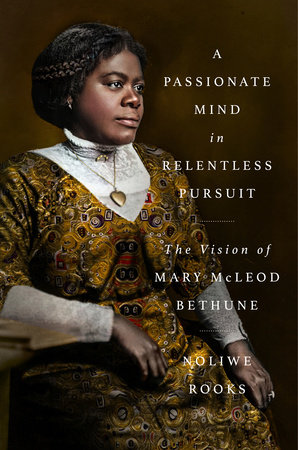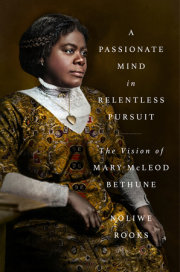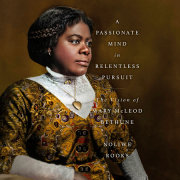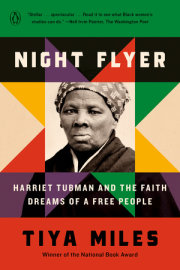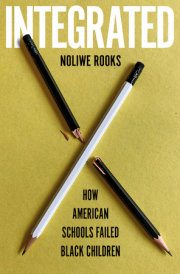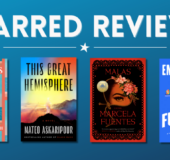1
"MY NAME IS
MRS. BETHUNE"
In November 1938, Bull Connor, the commissioner of Public Safety in Birmingham, Alabama, and an ardent segregationist, threatened to arrest Eleanor Roosevelt for sitting with Black people in public. What set Bull Connor, the first lady, and twelve hundred bystanders on a collision course was the inaugural meeting of the Southern Conference for Human Welfare, a group formed to discuss how Alabama and the rest of the South could reduce poverty, improve the equitable enforcement of civil and constitutional rights, make credit and banking more widely available across racial lines, improve public education, reform the sharecropping/farm tenancy system, and embrace democracy by repealing the poll tax. For many who thought things in the South were fine as they were, with Black people disenfranchised, undereducated, and overtaxed, these goals were controversial and led to charges in the local press that the conference was a front for socialists and communist sympathizers. But more than fear about the group's political agenda, the cries of "race mixing" garnered the lion's share of public and media attention. Newspaper articles reported that members of the city's Ku Klux Klan had found a woman who represented white women Democrats and was coming forward to warn everyone that the gathering was a ruse to allow Black men and white women to engage in sex with one another.
Sociologist and Fisk University president Charles Johnson reported that the attendees were a "curiously mixed body which included labor leaders and economists, farmers and sharecroppers, industrialists and social executives, government officials and civic leaders, ministers and politicians, students and interested individuals." There was one thing they had in common: they all knew that on the morning of the second day of the conference, Eleanor Roosevelt would be joining the proceedings. However, few were prepared for the sight that greeted them that morning: the entire Birmingham police department out in force at the conference center with the exterior of the auditorium encircled by police cars, wagons, and motorcycles. And inside, policemen stood or leaned against every wall. Bull Connor grabbed a bullhorn and announced that anyone who failed to "segregate apart" would face immediate arrest. The attendees obeyed, sorting themselves with Black people on one side of the auditorium and white people on the other. That is where things stood when Eleanor Roosevelt arrived with Mary McLeod Bethune by her side. Ignoring the police officers who tried to steer her to the white section, the first lady joined Bethune on the "Black" side of the room. A moment after they settled themselves, one of the policemen tapped Roosevelt on the shoulder and told her to move or face arrest. Instead of acquiescing, she produced a folding chair, placed it in the aisle between the white and Black sections, and declared she would not move again, saying, "I refuse to be segregated."
If you ever research Bethune's life, if you go looking for her in archives and oral histories, you will find that this recounting of Bethune and Eleanor Roosevelt arriving at the conference that day is an oft-told tale. I had seen the story about Eleanor Roosevelt defying Bull Connor, risking arrest, and challenging Birmingham's racial segregation laws so often that I had started to skim the words when some aspect of the event was mentioned. I found articles about the altercation in both the Black and the white press. I saw it in archives and in transcripts of audio recordings of speeches, and cited in biographical sources. Accounts always mention Eleanor Roosevelt, the first lady of the United States, and only passingly mention Mary McLeod Bethune, whom Black people at the time referred to as the "first lady of the struggle" or the "first lady of Black America." Sometimes, Bethune is not mentioned at all. Roosevelt is always the focus, and Bethune's presence is something akin to smoke rising to signal a recently extinguished fire. She is present, seen, undeniably there, but understood as the result or aftermath of something more notable having taken place. That's why I was so surprised when I came across an interview with the conference's organizer, Virginia Durr, who shared what had happened the evening before the police and the first lady arrived. Mrs. Bethune provoked an incident that set the conference attendees abuzz simply by rising and saying her name. Durr described the impact, on the first evening of the conference, of attendees being able to sit where they pleased. "It was thrilling; it was really marvelous. The new day had come; the whole South was coming together to make a new day, and it was just thrilling." She recalled,
The only thing I remember that happened particularly Sunday night was that Mrs. Louise Charlton, who had been one of the organizers . . . called on Mrs. Mary McLeod Bethune, and she called her Mary; she said, Mary, do you wish to come to the platform? And Mrs. Bethune got up . . . and she said, my name is Mrs. Bethune. So, Louise Charlton had to say Mrs. Bethune, will you come to the platform. Well, that sounds like a small thing now, but that was a big dividing line. A Negro woman in Birmingham, Alabama, called Mrs. Bethune at a public meeting!
When she stood, filled her lungs, and exhaled the word
Bethune in the alto tone and deliberate cadence that enthralled audiences, she announced that something new and distinct was possible, as clearly as if she had woven those exact words into sentences. She confirmed what all must surely have known, that erasing the color line involved more than where and with whom they sat but included calling a Black woman by the name to which she chose to answer. Mary, the name used to summon her to the podium, might be any number of people, but at that time, in that moment, there was only one Mrs. Bethune. A Black woman born poor and raised in the Jim Crow South, who had spent at least a decade at that point also working with government officials and wealthy philanthropists "up south" in the North, she well knew that publicly correcting a white woman risked more than rebuke; she understood that it could invite physical or economic harm. But she also knew her name and she had every reason to believe others knew it too.
By the time Mrs. Bethune rose and made clear how she should be addressed, she had spent the past decade providing her expertise to three US presidents. Her path to a seat at the national public policy table began in 1927 when Bethune attended a lunch hosted by Eleanor Roosevelt, the wife of Franklin Delano Roosevelt, who a year later would be elected governor of New York. When the white women in attendance, unused to socializing with Black people, refused to be seated with Bethune, Roosevelt placed Bethune beside her and invited any who objected to the seating arrangements to feel free to leave. The two developed a close friendship and political partnership that lasted through Eleanor's moving into the governor's mansion and later becoming the first lady.
Roosevelt advocated for Bethune to become an adviser to presidents, and the first knock on her door came in 1928, when Calvin Coolidge named her a delegate to a conference addressing child welfare in Washington, DC. Again, she was the only Black person invited to take part. That opportunity led to others. A year later, in 1929, Herbert Hoover asked her to serve on the National Commission for Child Welfare. In that role, she helped to design national surveys on health conditions, infant mortality, and public health programs. The results led to the establishment of the short-lived Child Health Day, programs to professionalize training for midwives, the passage of child labor laws, and vaccination programs to eliminate smallpox and diphtheria. In 1936, President Franklin Delano Roosevelt appointed her to the National Youth Administration (NYA), a federal agency created as part of the Depression-era Works Progress Administration (WPA). NYA programs funneled federal Depression-era relief money, training, programs, and employment opportunities to young people between the ages of sixteen and twenty-five. Bethune lobbied the agency so aggressively and effectively to attend to the needs of Black people who met the qualifications that she earned a full-time staff position in 1938. When she rose to speak at the Birmingham conference, it was as the director of the Division of Negro Affairs. In that role, she was the first Black person ever to head a federal division and at the time was the highest-paid Black person to have worked for the US government. There is also a real argument to be made that through her various roles in the Roosevelt administration, she had an impact in shifting the Black vote from one that had been reliably assumed by Republicans, given that Abraham Lincoln had been a Republican, to a bulwark for the Democratic Party, a shift that had culminated a few years before with the 1936 presidential election.
Finally, she was also able to use her access to the highest reaches of government to advocate for and form a coalition of leaders comprised of Black employees of the federal government. They were called the Federal Council of Negro Affairs. It came to be known as the Black Cabinet and served as an informal advisory board to the Roosevelt administration on issues facing Black people in the United States. Whenever the Black Cabinet gathered to meet, they did so either in Bethune's Capitol Hill office or in the living room of her home. She was a woman of drive, impact, and acclaim who at different stages of her life wielded an unusual amount of power. This last might explain why it is so easy to find instances where her friends, biographers, and colleagues describe her as arrogant, plain, dictatorial, unattractive, fat, and difficult. One of the Black cabinet members, Robert Weaver, said she had the "marvelous gift of effecting feminine helplessness in order to attain her aims with masculine ruthlessness."
When I first read Weaver's opinion of Bethune and tried to turn and twist it as one does when puzzling over the missing pieces needed to create a recognizable border framing a completed life, one of her accomplishments that came to mind involved her role in founding the World War II-era all-Black Air Force unit, the Tuskegee Airmen. She began work toward this goal in 1938 as a way to include Black colleges and universities in FDR's newly instituted Civilian Pilot Training Program, an initiative to ensure the nation had enough pilots in the event of war. The program was funded in part by the NYA and, fortuitously, Bethune headed its "Negro Section." She was determined not only to include Black colleges in the initiative but to use the whole as an opportunity to pursue integrating the nation's military. She also planned to have Black women serve as nurses who could provide medical and psychological counseling and support to the Black male pilots. She could clearly see that Black colleges sorely needed the money that came along with the program, Black people needed the military pay and benefits it offered, and Black women needed the opportunity to train for careers in nursing. As soon as the program was announced, she began lobbying President Roosevelt, urging him to extend the opportunity to Black colleges and Black people and to resist the perspective of the southern wing of the Democratic Party, who were ardent segregationists and did not want the military integrated or the federal government to offer Black people any type of training for which the federal government would pay.
Bethune prevailed and was soon able to get Tuskegee Institute, Hampton University, Virginia State, North Carolina A&T State, Delaware State, West Virginia State, and Howard University included among the colleges and universities participating in the federally funded Civilian Pilot Training Program. West Virginia State College became the first Black school to receive a military airplane in 1939. The Tuskegee Institute received its authorization and plane a few months later, in October of that same year. This was necessary forward movement but not enough to guarantee President Roosevelt would authorize the pilots to become a recognized military unit and fight in the war. Up until that point, most Black people in the military served in roles that were administrative or janitorial, or involved food service. They certainly did not fly planes. Bethune continued to strategize and soon devised a plan requiring the participation of her friend and ally of over a decade, Eleanor Roosevelt.
Roosevelt and Bethune together paid a visit to the Tuskegee Institute's Moton Field in 1941 and despite objections from her Secret Service detail, the first lady asked the chief flight instructor and Tuskegee pilot Charles Anderson if he would take her up in a plane. In what was "possibly the first time a Black man had ever flown a plane with a white woman as his passenger," Roosevelt spent more than an hour flying around in the skies over Tuskegee. Once back on the ground and in Washington, Roosevelt and Bethune used the success of the flight and the exhilaration of the experience to continue to entreat the president to integrate the military and allow the pilots to fly. In December 1942, the president issued Executive Order 9279 ending segregation in the military. Initially christened the Fighter Squadron, and then named the Tuskegee Airmen, the pilots trained at Black colleges became the first squadron of Black pilots to fight in World War II. I have a great-uncle, Virgil Richardson, who was a Tuskegee Airman. I grew up knowing that about him, but I did not know until researching Bethune's life that she was a large part of the reason he had the opportunity to soar.
Mrs. Bethune is generally remembered today as an educator. It is true that she believed deeply in the power of education; she owed a large debt to how it had shaped her life from the age of twelve, when she became the first in her family to sit in a classroom. But education is just part of her story. She was a woman of "firsts." The fifteenth of seventeen children born to her parents in Maysville, South Carolina, she was the first born free, not as enslaved property. She was the first Black woman to establish a historically Black college for Black girls in the eastern part of the United States. Bethune was also the first to found a hospital for Black people in the state of Florida. Her "firsts" are a song of Black survival and safety. Her life was a multipart composition that climbed octaves and harmonized the individual, the cultural, the political, and the economic. She was a political theorist and visionary, a pragmatist who shape-shifted, a woman of consequence who strategized how the federal government, voting rights, Black capitalism, economic development, Black organizations, and Black segregation could sustain Black men, women, children, and old people during the hand-to-hand combat phase of the Black freedom struggle that was the Jim Crow era. She was clear-sighted and truth-speaking about the evils of segregation and the South's desire for it. In the late 1920s she argued that the commitment to Black inferiority was stubbornly in defiance of the basic tenets of capitalism:
Copyright © 2024 by Noliwe Rooks. All rights reserved. No part of this excerpt may be reproduced or reprinted without permission in writing from the publisher.

